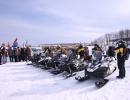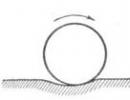Lexical topic "profession". Professions and specialties of the construction industry Pros and cons of the profession of a bricklayer
Lesson script
Technology 8th grade
Chapter:"Professional self-determination."
Subject: Professions and specialties of the construction industry.
Lesson form: debate + game
Purpose of the lesson: 1. Introduce students to professions and specialties in the construction industry.
2. Give an idea of the professionally important qualities of construction professions and specialties.
3. Prepare children for the right choice of profession and educational profile
Used Books: 1. Textbook "Technology" 8th grade for
educational institutions V.D. Simonenko. Moscow,
Ventanagraf Publishing House, 2009
2. Technology. Materials for the lessons of the section
“Professional self-determination” according to the program
V.D. Simonenko, A.N., Bobrovskaya. Volgograd, publishing house
"Teacher", 2007
3. Psychological analysis and professional charts.
99 popular professions. E.S. Romanova. Saint Petersburg,
publishing house "Peter", 2006
4. Where to go to study? Directory of institutions
vocational education of the Kemerovo region
2009-2010 academic year. M.S. Bortnikova, K.R. Zhuravleva.
Kemerovo, 2009
Equipment: computer, projector, computer presentation “Architecture and Construction”
and “Education institutions for vocational education in the construction industry”
posters “Man is famous for his work”, “A worker is the one who creates everything in the world”,
crossword on the board.
DURING THE CLASSES
- Organizational moment
Check student attendance and readiness for class
2. New material
Teacher: Before I tell you what professions we will talk about today, I want to ask you a riddle.
Lays brick by brick -
Growing floor by floor,
And every hour, every day
Higher and higher is the new house.
Students: They answer that he is a builder.
Teacher: That’s right, today our lesson will focus on builders. Construction professions are in great demand in our region and city. And we’re not just talking about blue-collar jobs; specialists in construction are also needed.
What construction professions do you know?
Students: painter
plasterer
plumber
electrician
mason
Teacher: Well done guys, but that’s not all and adds:
roofer
tiler
crane operator
excavator operator
bulldozer
architect
Teacher: Now let's take a short excursion into the history of architecture and construction.
(Presentation 1)
Teacher:. So, the architect gets to work first on building a house.
Student 1 An architect builds a house
The house is multi-storey.
Builds a house with a pencil
On a piece of paper.
You need to draw everything
Calculate, check,
Stairs and doors.
May it stand for many years
So that there is light in the apartment,
Baths, washbasins
For big and small.
Teacher: When the building design and all documentation are ready, they begin to prepare the construction site. The first to arrive at the construction site is a bulldozer. What kind of work does he do? Levels the surface of the site.
The full lesson can be downloaded at the beginning of the page
Reproduction of materials on other sites is possible only by using a hyperlink to this page or to the main page of the site
Construction is one of the seemingly eternal professions. But there are many nuances that you need to know in order to succeed in it.
A construction worker and a migrant worker are not the same thing
Many people make the mistake of thinking that a builder is the one who lays the bricks. In fact, builders are conventionally divided into two groups: construction workers (the “hands” of construction) and engineering workers (the “brains” of construction). Because a builder is not even a profession, but a collective concept.
"Hands" of construction
Let's be honest: not everyone wants to work in an office. There are and have been professions created for those who respect working with their hands: masons, roofers, installers, painters, electric and gas welders... If these people weren’t there, today we wouldn’t live in new buildings, wouldn’t drive on new highways, wouldn’t walk on modern ones entertainment centers.
A mason lays a foundation and builds walls from blocks or bricks. Must know the properties of mortars, masonry systems, requirements for masonry quality, types of parts and prefabricated structures.
The roofer covers and repairs roofs, produces hydro-, heat- and vapor barriers, and prepares materials for sealing joints and seams.
The installer sets up wiring and lighting, installs electric motors, transformers and other equipment, runs overhead lines and lays cables in the ground.
The painter ensures the appearance of the finished structures. Must know technologies and methods for painting various types of surfaces with pre-applied insulating and/or waterproofing coatings, the chemical composition of paints and rules for selecting colors, technical conditions for finishing and drying products.
An electric gas welder welds parts, components, structures and pipelines made of structural steel, cast iron, non-ferrous metals; cleans and prepares for painting.
The foreman does the same as the workers, but is still responsible for the overall work.
To master one of these professions, studying at a vocational school is enough. All listed specialties have 5 categories (from 2nd to 6th). Vocational school graduates are assigned the 3rd or 4th category. It makes sense to increase it - the rank affects the salary. This can be done while working.
It is also easy to retrain at a construction site - working in a team, you can actually gain experience from your colleagues and master an additional specialty.
A career in construction can be built in this direction: become a foreman, then a foreman.
"Brain" of construction
A civil engineer receives a higher education in the basic construction specialty of PGS (industrial and civil construction).
There are divisions within the profession: designers, estimators, production workers, designers, electricians, chief engineers, etc.
An engineer must know building codes and regulations (SNiP), estimate and design documentation, GOSTs. Must have independent drafting and blueprint reading skills. Proficient in special programs such as Avtocad, GrandSmet. Many employers specify knowledge of technical English as a prerequisite.
With a diploma in civil engineering, you can go to work on a construction site or in a technical production department (preproduction engineer, quality engineer, cost estimate engineer).
If an engineer chooses to work on a construction site, his career may begin as a foreman.
The foreman organizes work at a construction site. He explains tasks to workers and monitors their implementation. Provides safe working conditions. Orders materials, calculates the number of employees, determines compliance with the project, maintains documentation.
Further, an engineer's career can develop to the head of a department or project, chief engineer, deputy or director of a construction company.
Construction industry salary overview*
Specialty Average salary (RUB)
Construction industry salary overview*
|
Speciality |
Average salary (RUB) |
||
|
Moscow |
Moscow region |
Kazan |
|
|
mason |
|||
|
installer |
|||
|
roofer |
|||
|
electric and gas welder |
|||
|
foreman |
|||
|
designer |
|||
|
constructor |
|||
|
electrician |
|||
|
Chief Engineer |
|||
* According to worka.yandex.ru
Why is it difficult to be a builder??If we talk about working specialties in construction, this is, of course, hard work. You need to carry construction materials and work in any weather. The work is dusty in the literal sense of the word: you have to breathe dust and harmful substances. Accidents are not uncommon at construction sites.
If we talk about engineers, the difficulty here lies in the high responsibility that falls on their shoulders.
But not so long ago the profession was honorable. She enjoyed special respect in the post-war years. What seems so familiar to us today - high-rise buildings, shops, factories - was just beginning to be built en masse then.
In the 2000s, people went into construction for the money. A person with “hands”, even with a primary education, could receive a very decent salary and earn extra money if desired.
But after the 2008 crisis, a lot has changed. The profession's ratings have fallen sharply, as have salaries. Employers cut back where they could cut, many were fired, and many crews left on their own.
Who said that our people don’t want to work?
Back in the 1990s and 2000s, there were no migrants from the southern republics of the former USSR at construction sites. Russians worked, and the work was not considered “dirty.” It was possible to get an apartment after serving the required amount.
Now some people have the impression that Russians do not want to work in construction, in housing and communal services, etc., so migrants work there. In fact, this is a double-edged sword: developers are chasing excess profits, using cheap labor - people who can be underpaid and kept in unimaginable living conditions. Migrant workers agree to this, Russians do not.
The situation would be resolved in favor of “ours” if the market were regulated by the state, as it is in, say, the USA and Great Britain: minimum wages are established there, but not in Russia.
But still, one cannot say that Russians do not want to work. Yes, it is possible that a Muscovite who has received a higher education will not choose a working specialty in construction, because he does not want to work for that kind of money. But residents of the Moscow region and regions are ready to take on this work. And there is a demand for them - there is always a shortage of qualified personnel at construction sites.
“In the regions, salaries of 30,000-40,000 rubles are above average. So they go to Moscow to work. Work - on a rotational basis: 2 weeks there, 2 weeks at home. There is no point in moving permanently and even with your family - life in Moscow will be worse due to the lack of your own housing.”
Yuri, 55 years old
According to statistics from the website rjob.ru for 2012, the most in-demand construction specialties are installers. Electricians are in 2nd place, and designers are in 3rd place.
A house without heat is something very uncomfortable, and in the cold season it is also uninhabitable. Therefore, in Rus' the profession of a stove maker has always been held in high esteem. Building a stove is a real skill, and fireplaces are considered a decorative art. A good stove maker, capable of creating a stove that works flawlessly and is also beautiful, is a rarity. We were lucky enough to meet one of these virtuoso specialists. Igor Anatolyevich Negreev, a stove maker with 20 years of experience, who has given warmth to tens of thousands of people in his life, talks about the secrets of his business.
Igor Anatolyevich, please tell us about yourself. How many years have you been in the baking business?
- Since September 18, 1990.
Who taught you this art?
- My father-in-law, Vladimir Alekseevich Shpakovich. He taught both me and my son.
So you have a whole dynasty of stove makers! It all started with Vladimir Alekseevich; before him, no one in the family made stoves?
- Exactly. Vladimir Alekseevich graduated from Voenmekh, worked as a leading design engineer, and on weekends he worked as a stove maker. They lived in Magadan, but it was not hot there.
Did your father-in-law install heating stoves?
- Not only. He even patented one of the stoves - a special block one. Such a stove is not made of bricks, but of ready-made blocks. Assembly drawings are included with them. It's somewhat similar to a children's construction set. I assembled it and that’s it, no need to lay bricks.
Who makes these blocks?
- Borovichi, Borovichevsky plant. This is the only place in the North-West where refractory products are produced: bricks, blocks, clay, mixture.
Is Vladimir Alekseevich still working?
- Yes, he has been working for seventy-three years. He still remains cheerful and energetic.
Stove maker is a profession that is directly related to fire. Is knowledge of fire safety requirements controlled among stove makers?
- Undoubtedly. Stove makers are among those 105 specialties in Russia that must be licensed in Moscow. We must confirm our knowledge every 5 years, because the requirements change periodically.

What kind of stoves do you make?
- Variety. We work with any stoves and fireplaces, both for country houses, including stoves in the garden, and in city apartments, if they have chimneys. Where there is no chimney, we can make an electric fireplace, but this is rare.
Tell us about what types of stoves there are.
- There are heating and heating-cooking stoves. The first ones serve only to heat the room, while the second ones can also be used for cooking. Barbecue stoves, which are located in the garden, under a canopy or in a gazebo, are also in demand.
What oven products are the most popular?
- Mainly heating and cooking stoves. In addition, complex solutions are in demand: a cooking and heating stove, a heat shield (warm wall) and a fireplace - this is, as they say, “in one bottle.” As a rule, we build a stove in the kitchen and a fireplace in the living room. Thus, in the kitchen you can cook in the oven, and in the room you can admire the fireplace, which serves a largely decorative function. The heat shield, like the pipe, is made common to both the stove and the fireplace, and thus heats both rooms.
Who are the main customers for this option? Owners of country houses?
- Yes, as a rule, these are residents of gardens and country villages. Orders for fireplaces in the city are somewhat less common.

How long does it take to build a furnace?
- Time depends on the amount of work. Let's say there are a certain number of bricks that need to be laid. It depends on the height of the house, the distance of the foundation, the wishes of the customer... In addition, I give additional recommendations. I cannot install a small stove in a large room, because per 10 cubic meters there must be 1 square meter of surface that gives off heat. Most often I start work with calculations. And then I recommend the oven and calculate the number of bricks. Usually we work together, and each day we lay from 80 to 100 bricks. The stove in an ordinary one-story house with an attic is a cooking and heating stove. It consists of a stove with a deck (cooking surface), a heat shield, a fireplace and a chimney under the roof. Such a stove takes from 1000 to 1300 bricks. But there are exceptions, for example, we had a facility in Toksovo - a three-story cottage. There, of course, they didn’t meet the thousand.
What size is the average heating stove?
- 750 mm by 750 mm - two cubic meters.
And how much does such a stove cost?
- The cost of furnaces depends on the cubic capacity. The price of one cubic meter is 27.5 thousand rubles. The number of cubic meters is calculated from the volume of the furnace and the dimensions of the pipe.
Do you work outside?
- Yes, we work from 3 to 5 days, then we take 2 days off. Sometimes we travel so far that we are not able to return home every day.
Let's talk about finishing. They say that good brick, for example, Baltic, can itself act as decoration.
- Yes, this is brick laying “for jointing”.
Why is the appearance of such a brick valued? Are there any patterns on it?
- There are also patterns, but, in general, the brick is remarkable in that it is very smooth, there are no edges, there are no sharp corners.
A few words about garden stoves. Most likely, such a stove needs a serious foundation? Is it possible to put a barbecue in a ready-made gazebo?
- Yes, we need a foundation. Usually we plan the size and depth of the bookmark in advance.
What is the best thing to do for those who decide to build a barbecue in a ready-made gazebo?
- In such cases, it is necessary to strengthen the foundation.
That is, is it better to first install a stove and then build a gazebo around it?
- It is more correct to start furnace work when the room is already half ready - the walls are built, the level of the roof and ceiling is known. Furnace work is dirty, so it is better to carry it out until the finishing is finished.
Is a garden stove essentially an open fire that you cook with?
- Yes, you can cook kebabs, you can make barbecue - fried meat in French. There are barbecue ovens in which the customer asks to make a small oven with a damper for cooking pies, like in Russian fairy tales.

Who makes the dampers?
- We know blacksmiths and welders. In addition, stove accessories are sold in stores - from various materials, from different countries: Germany, Finland, France, Sweden, Belarus, Russia, Poland...
What new and interesting things have appeared in the furnace business lately?
- As for the fittings, interesting doors with fire-resistant glass have appeared, thanks to which the owners can observe the fire in the stove. Among the new products, we can also note rotary valves, electric valves, and many options for flooring (cooking surfaces).
Is anyone today ordering stoves with beds similar to those that used to be in peasant huts?
- Yes, they order Russian stoves. We recently worked in the Nakhimovsky camp, and on the first floor alone I laid 2,500 thousand bricks, since a Russian stove with a stove bench was ordered.
How many people can fit on such a bed?
- Three.
Imagine this situation: they decided to light a fireplace that had not been used for 150 years, but it started smoking. Do you need to contact a stove maker?
- First, you should call a chimney sweep.

And if a person himself built a stove at home, but it does not heat, it smokes. What to do?
- Call us. Depending on the situation, we will decide how to act. You may have to break everything or just half. Recently there was an incident in Sablino: we left the heat shield, but made new stove and pipe.
It turns out that if people decide to build a stove on their own, there is a very high probability of doing something wrong?
- Life experience suggests that all people who want to have a stove in their home are divided into two categories: those who read literature and study technology in order to understand what a stove maker does in the process of work, and those who try to make a stove on their own. Both of them are our clients. Only in the first case we come to build, and in the second - to repair.
A construction worker and a migrant worker are not the same thing
Many people make the mistake of thinking that a builder is someone who lays bricks. In fact, builders are conventionally divided into two groups: construction workers (the “hands” of construction) and engineering workers (the “brains” of construction). Because a builder is not even a profession, but a collective concept.
"Hands" of construction
Let's be honest: not everyone wants to work in an office. There are and have been professions created for those who respect working with their hands: masons, roofers, installers, painters, electric and gas welders... If these people weren’t there, today we wouldn’t live in new buildings, wouldn’t drive on new highways, wouldn’t walk on modern ones entertainment centers.
Mason lays the foundation, builds walls from blocks or bricks. Must know the properties of mortars, masonry systems, requirements for masonry quality, types of parts and prefabricated structures.
Roofer covers and repairs roofs, produces hydro-, heat- and vapor barriers, prepares materials for sealing joints and seams.
Installer installs wiring and lighting, installs electric motors, transformers and other equipment, installs overhead lines and lays cables in the ground.
Painter provides the appearance of finished structures. Must know technologies and methods for painting various types of surfaces with pre-applied insulating and/or waterproofing coatings, the chemical composition of paints and rules for selecting colors, technical conditions for finishing and drying products.
Electric and gas welder welds parts, components, structures and pipelines made of structural steel, cast iron, non-ferrous metals; cleans and prepares for painting.
Brigadier does the same thing as workers, but is also responsible for general labor.
To master one of these professions, studying at a vocational school is enough. For example, in Vocational School No. 72, Vocational School No. 69 or Vocational School No. 40.
All listed specialties have 5 categories (from 2nd to 6th). Vocational school graduates are assigned the 3rd or 4th category. It makes sense to increase it - the rank affects the salary. This can be done while working.
It is also easy to retrain at a construction site - working in a team, you can really gain experience from your colleagues and master an additional specialty.
A career in construction can be built in this direction: become a foreman, then a foreman.
"Brain" of construction
A civil engineer receives a higher education in the basic construction specialty of PGS (industrial and civil construction). For example, at the Military Technical University under the Federal Agency for Special Construction or at the Moscow State Academy of Utilities and Construction (has branches in 5 cities in the region).
There are divisions within the profession: designers, estimators, production workers, designers, electricians, chief engineers, etc.
An engineer must know building codes and regulations (SNiP), estimate and design documentation, GOSTs. Must have independent drafting and blueprint reading skills. Proficient in special programs such as Avtocad, GrandSmet. Many employers specify knowledge of technical English as a prerequisite.
With a diploma in civil engineering, you can go to work on a construction site or in a technical production department (preproduction engineer, quality engineer, cost estimate engineer).
If an engineer chooses to work on a construction site, his career may begin as a foreman.
The foreman organizes work at a construction site. He explains tasks to workers and monitors their implementation. Provides safe working conditions. Orders materials, calculates the number of employees, determines compliance with the project, maintains documentation.

Why is it difficult to be a builder?
If we talk about working specialties in construction, this is, of course, hard work. You need to carry construction materials and work in any weather. The work is dusty in the literal sense of the word: you have to breathe dust and harmful substances. Accidents are not uncommon at construction sites.
If we talk about engineers, the difficulty here lies in the high responsibility that falls on their shoulders.
But not so long ago the profession was honorable. She enjoyed special respect in the post-war years. What seems so familiar to us today - high-rise buildings, shops, factories - was just beginning to be built en masse then.
In the 2000s, people went into construction for the money. A person with “hands”, even with a primary education, could receive a very decent salary and earn extra money if desired.
But after the 2008 crisis, a lot has changed. The profession's ratings have fallen sharply, as have salaries. Employers cut back where they could cut, many were fired, and many crews left on their own.


CHILDREN SHOULD KNOW:
Names of different professions.
Purpose of different professions.
CHILDREN SHOULD KNOW NOUNS: doctor, builder, teacher, fireman, photographer, cook, hairdresser, policeman, tailor, shoemaker, baker, writer, pilot, driver, librarian, salesman, gardener, carpenter, painter, bricklayer, electrician, crane operator, excavator operator , welder, glazier, craftsman, architect, tractor driver, combine operator, milkmaid, poultry worker, pediatrician, dentist, ophthalmologist, surgeon, neurologist, nurse.
ADJECTIVES: kind, attentive, caring, responsible, professional, skillful, knowledgeable, conscientious, disciplined;
VERBS: treats, teaches, educates, stews, photographs, cooks, cooks, cuts, lays, looks after, sews, mends, cuts, bakes, writes, composes, flies, drives, carries, gives out, receives, sells, counts, cares, grows, lays, installs, lifts, manages, paints, digs, plans, glass, welds, sows, plants, digs.
ONE IS MANY.
Teacher - teachers - teachers.
Doctor - doctors - doctors.
Seller - sellers - sellers.
Baker - bakers - bakers.
Photographer - photographers - photographers.
Tailor - tailors - tailors.
Milkmaid - milkmaids - milkmaids.
Postman - postmen - postmen.
NAME BY MODEL (children over 6 years old):
He is an artist and she is an artist.
He is a teacher and she is... .
He is a writer, and she is... .
He is a conductor, and she is... .
He is a singer and she is... .
He is a translator, and she is... .
WHO'S DOING WHAT?
Teacher - teaches reading, writing, counting.
A fireman puts out a fire.
Builder - builds and repairs houses.
Painter-plasterer - paints, whitewashes, plasters.
Photographer - takes photographs.
Cook - ... .
Tailor - ... .
Hairdresser - ... .
Librarian -...
Doctor - ... .
Writer - ... .
Driver - ... .
Tractor driver - ... .
Milkmaid - ... .
Poultry - ... .
WHO NEEDS WHAT FOR WORK?
Hairdresser - scissors, comb, hair dryer, curlers.
To the doctor - medicine, a white coat, a thermometer.
To the artist - ... .
To the teacher - ... .
To the tailor - ... .
Painter - ... .
Rybolov - ... .
To the seller - ... .
To the gardener - ... .
Carpenter - ... .
Milkmaid - ... .
To the tractor driver - ... .
GUESS THE PROFESSION (children over 6 years old).
Who carries the luggage? (Porter.)
Who welds the pipes? (Welder.)
Who installs the glass? (Glazier.)
Who works on the crane? (Crane operator.)
Who lays the bricks? (Mason.)
Who sharpens knives? (Grinder.)
Who repairs the clock? (Watchmaker.)
Who works on an excavator? (Excavator operator.)
Who paints the walls? (Painter.)
Who takes care of the birds? (Birdwoman).
Who composes the music? (Composer.)
Who plays the piano? (Pianist.)
CONFUSION.
A painter sews clothes.
The driver controls the plane.
The hairdresser knits a sweater.
The librarian delivers mail.
The photographer composes music.
A tractor driver sews clothes.
DESCRIBE YOUR PROFESSION ACCORDING TO YOUR PLAN:
Name of profession.
What tools are needed to work in this profession.
What does a person in this profession do?
NAME (children over 6 years old):
Children's doctor - ... (pediatrician).
Dentist - ... (dentist).
Eye doctor - ... (ophthalmologist).
The doctor who performs the operation is ... (surgeon).
The doctor who treats nerves is ... (neurologist).
Physician assistant - ... (nurse).
Medical clothing - ... (cap, headscarf, gown, gloves).
Medical instruments - ... (syringe, spatula, pipette, thermometer, hammer, tweezers).
What is a profession? (Business, work, occupation.)
Name your parents' professions.
What are professions for?
What do you want to be when you grow up?
Why do you need to study professions? Where are they taught?
We get up very early, because our concern is
Drive everyone to work in the morning. (Driver.)
Will guide the glass eye,
Click once - and we remember you. (Photographer.)
We must fight fire -
We are partners with water.
They won't be afraid with us
Carbon gases are bad for you.
People really need us,
So who are we? - ... (Firefighters).
Tell me who is so delicious
Prepares cabbage soup,
Smelling cutlets, salads, vinaigrettes,
All breakfasts, lunches? (Cook.)
SAY A WORD.
In the carpenter's bag you will find a hammer and a sharp... (knife).
Any tool is available - a plane, and... (a chisel).
We must fight fire.
We are brave workers.
We are partners with water.
People really need us.
So who are we? - ... (firemen).
I would be a pilot pilot
I definitely wanted to become
I was on a plane then
I would have reached Moscow... (Flew).
The hasty thread runs after the needle
I can do anything for myself... (sew).
It's not hard for me to mend a sock myself
Fix the pocket, sew it down... (belt).
There are probably a thousand pounds in it!
Heavy... (threshing).
I'm not bragging, I'll say:
I will make all my friends younger!
Despondent people come to me -
With wrinkles, with folds.
They are leaving very nice -
Fun and smooth.
So I'm a reliable friend
Electric... (iron).
In a world of diverse words,
What shines, burns and burns
Gold, steel. Diamond
There is no more sacred word... (labor).
The pilot lifts into the blue sky... (plane).
He drove the goats out onto the mound, cheerful... (shepherd boy).
Plane in hand - another job:
Knots, squiggles with a plane... (planing).
But our painter does not come into the house with a brush and a bucket:
Instead of a brush, he brought a mechanical... (pump).
So that people don't get wet in the rain
The roofer covers... (the house) with iron.
A crane is moving - a huge height
Delivers iron... (sheets) to the roof.
White sawdust is flying, flying from under the saw:
This carpenter makes frames and... (floors).
Should we buy bread or give us a gift -
You and I take the bag and go outside.
We walk along the shop windows and go into... (shop).
Well, in this store there is a pretzel, buns on the display,
Medicinal bread with bran. The store is called... (bread store).
Every day a newspaper is brought to our house... (the postman).
Seven brave young mowers were sharpening their scythes and cutting the grass... (mowed).
The roof is being painted in front of the children... (painters).
We are taking the boards up the mountain, we will build a new one... (house)
I fly dolls in the morning. Today I... (nurse).
It's time to paint the rooms. They invited... (painter). Baruzdin S.
The circus performer knows how to prance, animals and birds... (train).
Ir-ir-ir-my dad... (commander).
The future cabin boy brought us some southern fish... (sailor).
She didn’t drink or sleep, she gnawed on a tree... (saw).
The sharp-nosed one sews, stitches and pricks... (needle).







